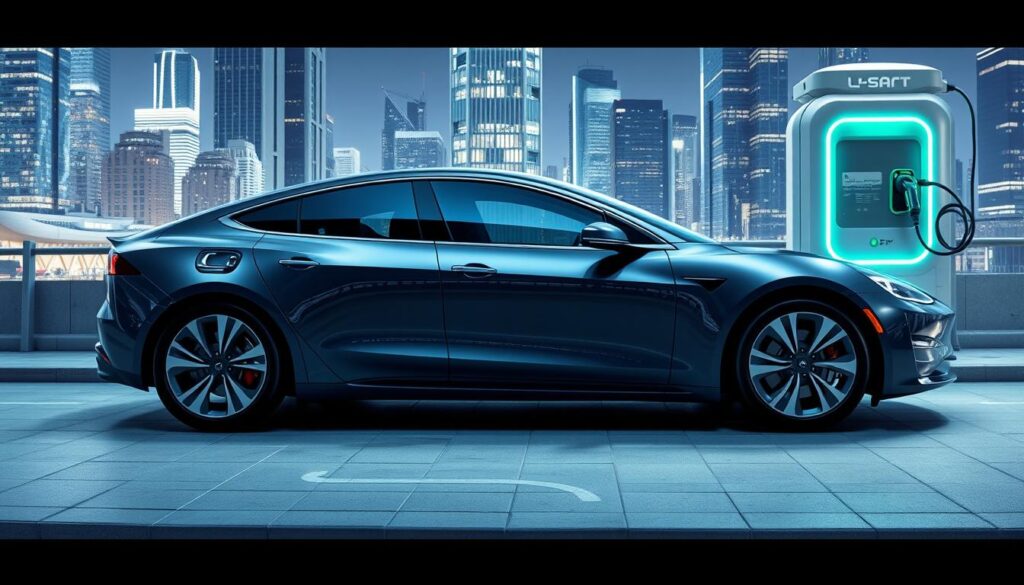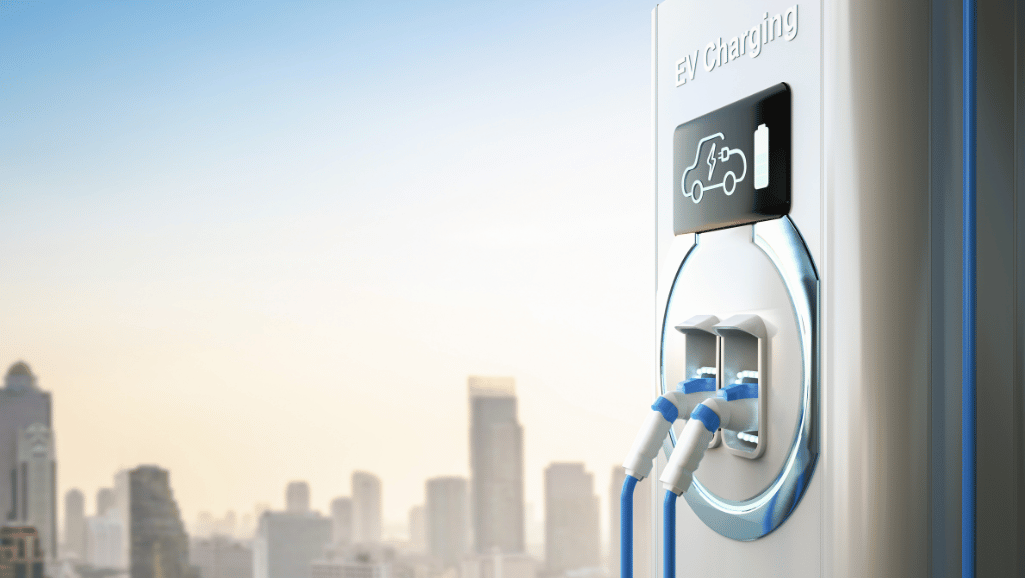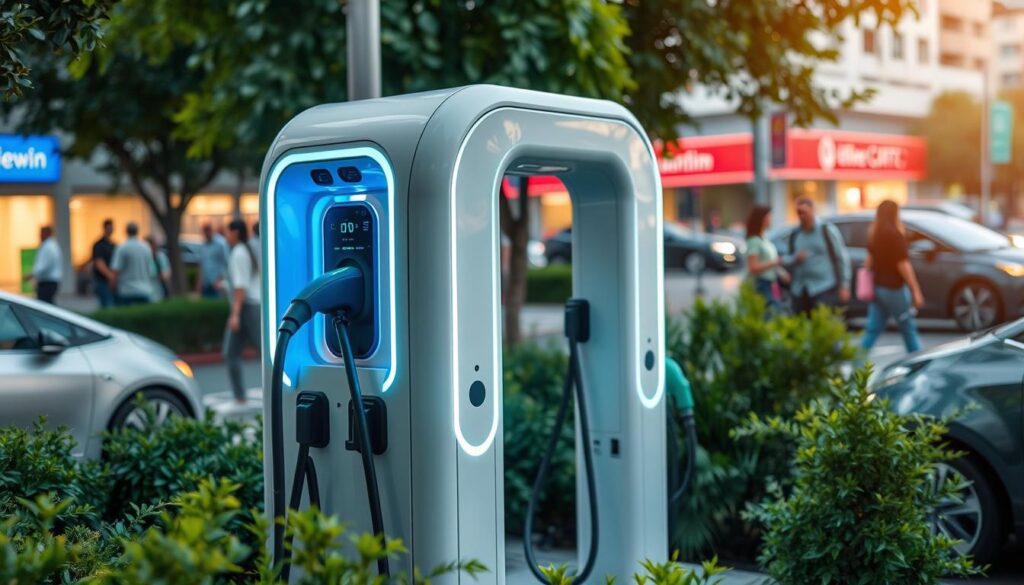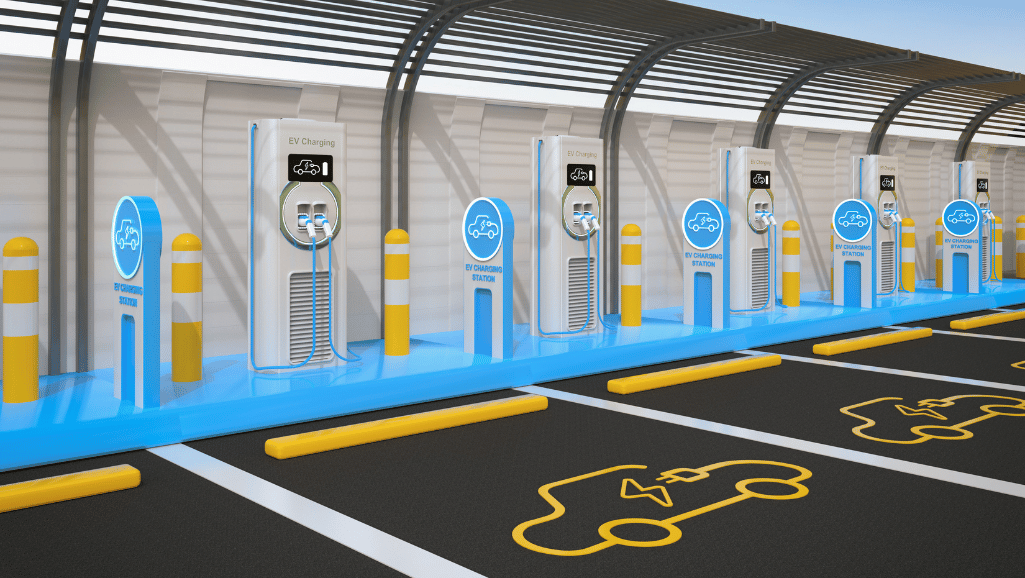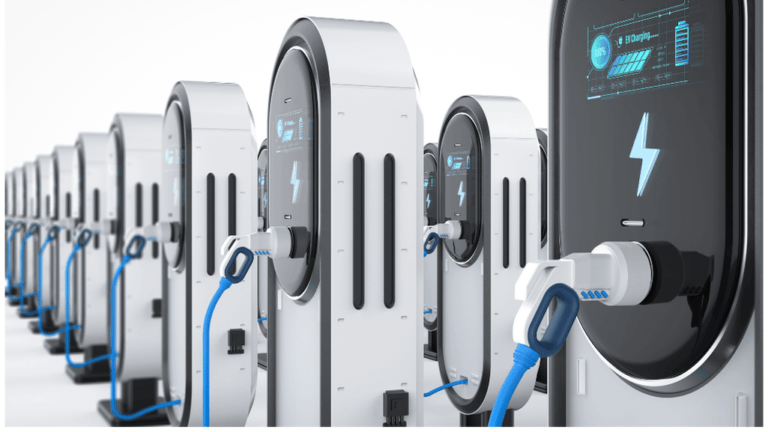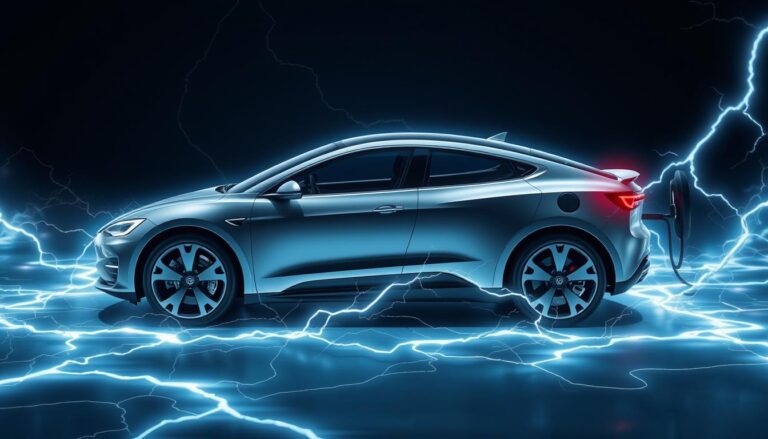Today’s electric vehicles (EVs) use advanced electric charging solutions. This leads to a future where charging is fast, easy, and efficient. A growing charging infrastructure is making EVs more appealing. Now, using RFID/NFC cards or smartphones makes charging simple for drivers.
Technology like the Kempower Satellite is making charging better. It offers features like smart cable management and easy-to-use touchscreens. This makes charging faster and more convenient.
The Kempower Power Unit is a big step forward in charging technology. It can charge many EV charging stations at once. This shows how the electric charging landscape is changing fast. It’s all about making charging easy and efficient for everyone.
Key Takeaways
- Enhanced user interfaces with RFID/NFC and smartphone monitoring are becoming standard for EV charging.
- Technological innovations such as the Kempower Satellite elevate the recharging experience through superior cable handling and touchscreens.
- The Kempower Power Unit demonstrates a progressive step in energy distribution for EV charging stations.
- Continued expansion and sophistication of the charging infrastructure support the widespread adoption of EVs.
- Emergent solutions in electric car charging indicate a clear trajectory toward improved efficiency and increased accessibility.
- RFID/NFC card and smartphone app integration facilitate more secure and convenient charging sessions.
Understanding the Electric Vehicle Charging Landscape
The rise of electric vehicles (EVs) has led to a growth in EV charging infrastructure. This includes both public and private options. As we move towards a greener future, it’s key to understand this changing landscape for both consumers and businesses.
The Growth of Public and Private Charging Infrastructure
Recent data shows a big jump in EV charging infrastructure. In the last quarter, the Southeast saw a 7.8% increase in public charging spots. This growth helps meet the needs of the growing EV market and prepares for the expected 350 million EVs by 2030. Private charging options are also on the rise, showing that 64% of EV drivers prefer charging at home.
Key Differences Between Level 1, Level 2, and DC Fast Charging
Electric charging speeds and efficiency vary a lot between different levels. Level 1 charging is a basic option that adds 6 to 8 kilometers of range per hour, perfect for charging at home overnight. Level 2 charging speeds up the process, making it popular for work settings, with 34% of EV drivers using it. DC fast charging stations, which saw a 9.2% increase recently, offer quick charging for long trips and city driving.
Factors Influencing the Adoption of Electric Charging Stations
Many factors are pushing for more electric charging stations. Government help and lower EV prices make them more affordable. Improvements in DC fast charging technology help ease range anxiety. Plus, EVs are becoming part of bigger talks on grid evolution and smart charging. For more on commercial EVs and the latest trends, check out EV Next Gen.
| Charging Type | Q1 2023 Increase | Q2 2023 Increase | Q3 2023 Increase | Q4 2023 Increase |
|---|---|---|---|---|
| Public Ports | 4.0% | 4.1% | 8.4% | 5.2% |
| Private Ports | 1.7% | 3.4% | 2.8% | 3.5% |
| DC Fast Charging | 7.6% | 6.1% | 9.2% | 9.2% |
The electric vehicle market is set for huge growth. Improving the EV charging infrastructure is crucial for a sustainable automotive future.
Innovative Home Charging Solutions for Convenience and Efficiency
More people are buying electric vehicles (EVs), making home charging solutions more important. Products like the Tesla Wall Connector and ChargePoint Home Flex lead the way. They offer powerful, smart chargers that make charging easier every day.
Using home charging solutions helps more people use EVs. It also fits the needs of those who like technology that’s easy and efficient. Now, smart chargers like the Tesla Wall Connector or the ChargePoint Home Flex can be part of smart home systems. This is a big plus for homeowners.
The Role of Smart Chargers in Enhancing User Experience
Smart chargers are changing how EV owners charge their cars. They let you schedule charges, watch your energy use, and even control them from your phone. This makes charging easy and fun. Smart chargers work with home energy systems to help you use less energy and save money.
Assessing the Tesla Wall Connector and ChargePoint Home Flex Features
The Tesla Wall Connector and the ChargePoint Home Flex both charge quickly, cutting down on waiting time for EV owners. The Tesla Wall Connector works with Tesla cars and other EVs, making it a great choice for many. The ChargePoint Home Flex lets you adjust the charge speed to fit your home’s electrical setup.
As more people turn to renewable energy, these chargers are ready to work with solar power. This move towards clean energy will shape the future of home charging. With new tech like wireless charging and Vehicle-to-Grid systems, EVs will play a big role in managing energy at home and worldwide.
Thanks to ongoing tech improvements, home charging solutions like the Tesla Wall Connector and ChargePoint Home Flex are leading the way in the EV market. They make charging efficient and easy.
Exploring the Benefits of Fast Charging for EV Drivers
For electric vehicle (EV) owners, quick battery recharge is key, especially on long trips. Fast charging is a big step forward in cutting down recharge time. DC fast chargers can fill an EV’s battery to 80% in 20 to 30 minutes, much faster than Level 1 and Level 2 chargers.
Electric vehicle chargers with DC fast charging can give up to 350 kW of power. This means faster charging and a better way to handle long trips. But, these chargers are more expensive and complex to set up. Many EVs can’t yet use the highest power these chargers offer, showing how EV technology and charging stations are still evolving.
| Charging Type | Time to Charge | Cost per Charge | Typical Power Output |
|---|---|---|---|
| DC Fast Charger | 20 – 30 minutes (20% to 80%) | $10 – $30 | 50 kW – 350 kW |
| Level 1 & 2 Charger | Several hours | Varies | Lower than 20 kW |
Fast charging is efficient, but we still have a lot of work to do on the charging network. It’s not as widespread as gas stations, especially in rural areas. Fast charging can affect an EV’s battery health, depending on how often you use it and the conditions it’s in. But, normal charging usually doesn’t harm the battery. Extreme temperatures can, if the battery isn’t prepared.
To make fast charging better, we need to keep improving efficient EV charging tech. New EVs are getting better at handling heat, and smart charging uses renewable energy. As technology gets better, charging during off-peak times could become cheaper, making fast charging more appealing worldwide.
Dive into Electric Charging with Kempower’s Advanced Solutions
Kempower is at the forefront of electric vehicles (EVs) with solutions that are efficient and adaptable. They offer the Kempower Satellite, Charging Power Unit, and ChargEye system. These products blend strong electric charging technology with innovative design. They meet the needs of today’s electric vehicle infrastructure.
Kempower Satellite: A User-Friendly Charging Experience
The Kempower Satellite system is designed with the user in mind. It makes charging easy for drivers of all EV types. It’s great for fleets, where many vehicles need quick and reliable charging. It can expand as businesses grow, showing its flexibility and commitment to sustainable charging.
The Power and Flexibility of Kempower’s Charging Power Unit
Kempower’s Charging Power Unit can charge up to 600 kW, perfect for heavy-duty use like trucks and buses. Electric trucks will soon lead the EV market, needing strong charging solutions. Kempower’s tech ensures less downtime, crucial for companies switching to electric fleets.
Kempower ChargEye: Cloud-Based Charging Management System
Kempower ChargEye changes how we manage electric charging networks. This cloud-based charging management system gives real-time data and analytics. It helps operators optimize their operations and manage power well, making charging more efficient. ChargEye is great for places with lots of charging happening at once, preventing system overload.
As we move towards a more electric future, Kempower’s advanced charging solutions will be key. The Kempower Satellite, Charging Power Units, and ChargEye system show a smart way to meet the needs of electric transportation.
Commercial Electric Charging Stations: Paving the Way for Businesses
The growth of commercial electric vehicle chargers is a big step forward in green technology. It brings many benefits for both EV owners and businesses. By using EV charging solutions, companies can attract more customers who care about the environment. This is changing how we see electric car charging places.
More people are using EVs now, thanks to better awareness and laws. This has greatly helped the EV charging equipment industry grow. Companies are now working towards being more sustainable, shown by the rise in charging stations at workplaces.
There’s been a big increase in electric car charging stations, especially fast DC ones. These are set up in busy places like malls and offices. They offer a key service and draw in customers who value the planet. This can help businesses get more customers and keep them coming back.
| Charging Station Type | Location | Charging Speed |
|---|---|---|
| Level 2 Charging Stations | Office complexes, Public parking lots | Faster than home chargers |
| DC Fast Charging Stations | Highways, Major roads | Quickest available |
More commercial electric vehicle chargers are helping more people switch to EVs. This is good for the economy and the environment. These chargers cut down on pollution and make the air cleaner. They’re key to a greener future. For more on how to use these changes for your business, check out Electric Vehicles Next Gen. They offer tips on sustainable EV practices.
The growth of EV charging solutions is pushing businesses to add more charging stations. This keeps them competitive in a changing market. Adding charging to renewable energy sources shows a move towards sustainable business practices. For more on how EV charging is changing things, read our feature.
Public EV Charging Expansion Driven by Infrastructure Investments
Infrastructure investments have greatly increased public electric vehicle (EV) charging stations. This is thanks to laws like the 2021 Bipartisan Infrastructure Law. This law is key to making sure America has enough EV charging spots.
More people are buying electric vehicles, with over a million sold last year. This growth means we need more EV charging stations. The 2021 Bipartisan Infrastructure Law set aside $7.5 billion for this, aiming for over 500,000 public chargers by 2030.
The 2021 Bipartisan Infrastructure Law’s Impact on EV Charging
The 2021 Bipartisan Infrastructure Law is changing how we charge electric vehicles. It plans to build new stations along major roads, so they’re never more than 50 miles apart. This makes long trips easier and helps people feel secure about their car’s range.
Increase in Public Charging Options and Infrastructure Initiatives
Infrastructure investments are boosting the quality and speed of charging. Now, there are over 165,000 public charging ports. Plus, the U.S. is making 60,000 fast chargers a year, showing big growth in production.
| Charger Type | Range Per Hour of Charging | Number of Public Charging Ports (2023) |
|---|---|---|
| Level 1 | 5 miles | |
| Level 2 | 25 miles | Approx. 80% |
| DC Fast Charger | 100-200+ miles | Over 20% |
Every investment in infrastructure brings us closer to a world with easy EV charging. This means more people can switch to electric cars without hassle. It’s all about making electric driving easier and more reliable.
Alleviating Range Anxiety with Strategic Charging Stations Placement
Alleviating range anxiety is key to making electric vehicles more popular. Putting electric vehicle charging stations in cities, along highways, and near homes helps a lot. It makes owning an EV more practical. Having easy access to reliable charging infrastructure is crucial for daily driving and long trips.
Addressing EV Drivers’ Concerns with Accessible Charging Facilities
Having easy-to-use charging spots is vital for EV drivers. The International Energy Agency found a big jump in public charging spots, hitting over 1 million by late 2020. Fast charging spots that refill batteries from 0% to 80% in 20 to 30 minutes are especially helpful for long trips. They cut down charging time and make EVs more practical.
Developing a Reliable and Functional Electric Vehicle Charging Network
Building a dependable electric vehicle charging network is key for EV owners. By late 2022, there were 2.7 million public charging points worldwide, up 55% from the year before. This growth matches the growing EV market’s need for reliable charging solutions. For instance, V2G technology helps manage energy use and cuts costs by controlling power flow.
- 48% of future EV drivers list range anxiety as the main hesitation point in purchasing an electric vehicle.
- Education and awareness about EV capabilities and enhanced charging infrastructure are necessary to correct misconceptions and facilitate the EV transition.
In conclusion, solving range anxiety with smart placement of charging stations and strong infrastructure helps current and future EV users. It builds trust and encourages more people to buy EVs.
Revolutionizing Electric Vehicle Chargers: Smart Charge America’s Role
Smart Charge America is leading the way in EV charging technology. They’re making charging easier and creating new ways for businesses and users to make money. With AI and smart pricing, their electric charging stations are changing the game.
Smart Charge America offers smart chargers with future-proof connectivity and green operations. These chargers do more than just charge cars; they connect EVs with everyday life and the energy world.
Creating a Revenue-Generating Ecosystem with Smart Chargers
The chargers from Smart Charge America use dynamic pricing models. This means charging costs change based on the time and demand. EV owners can charge at the best price and help the power grid. Plus, they work even when the internet is down, making charging easy and reliable.
Ensuring Future-Proof Connectivity for EV Charging Stations
Smart Charge America makes sure its electric charging stations are ready for the future with future-proof connectivity. They have the latest hardware and software for updates, maintenance, and security. This keeps charging safe and follows strict rules.
IONNA plans to add many chargers in North. This shows how important good charging spots are. Smart Charge America is making its chargers better by working with networks like IONNA.
| Feature | Benefits | Impact |
|---|---|---|
| AI-driven charging schedules | Minimizes costs, reduces charging time | Improves user satisfaction and grid stability |
| Dynamic pricing models | Cost-effective charging dependent on demand and time | Financial savings for EV owners, less grid strain |
| Predictive maintenance | Decreases downtime, extends station lifespan | Enhances reliability and long-term serviceability |
Smart Charge America is not just improving EV charging technology. They’re creating smarter, connected, and green transport solutions for today’s cities and people.
Conclusion
The push for EV charging solutions is moving fast. By 2030, we’ll see 3.7 million Level 2 and 136,000 DC fast chargers for public use and workplaces. Plus, over 40 million chargers will support homes.
Private groups are already planning to cover 182% of needed DC fast chargers and about 62% of Level 2 chargers. This shows a big step towards a future where electric cars are key to getting around.
Hotels and shops are adding DC fast chargers to draw in customers who care about the planet. Companies like Kempower and Smart Charge America are leading the way with tech that’s easy to use and efficient.
Range anxiety is fading as charging spots become more common and easy to find. The U.S. already has about 61,000 charging stations, with ChargePoint operating around 34,000 of them. This makes people more confident in using electric cars.
Even though EV sales have slowed a bit, the government’s goal for half a million charging spots shows they’re still all in on electric cars. It’s important to keep an eye on the economy and make sure growth meets what people want and need.


